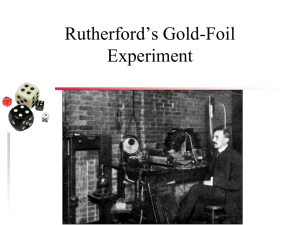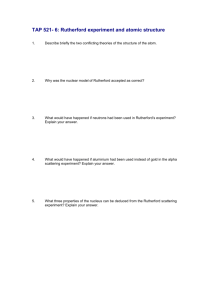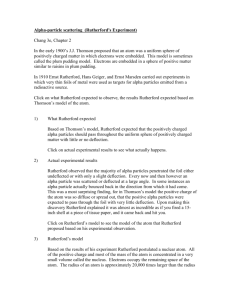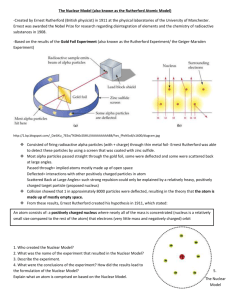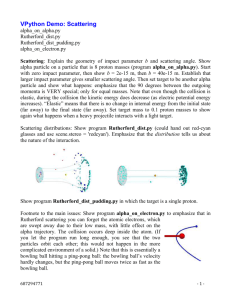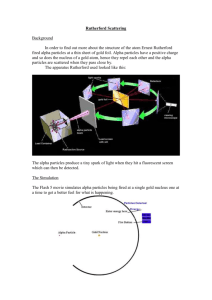David Wang Cluster 2 Final Cosmos Project
advertisement
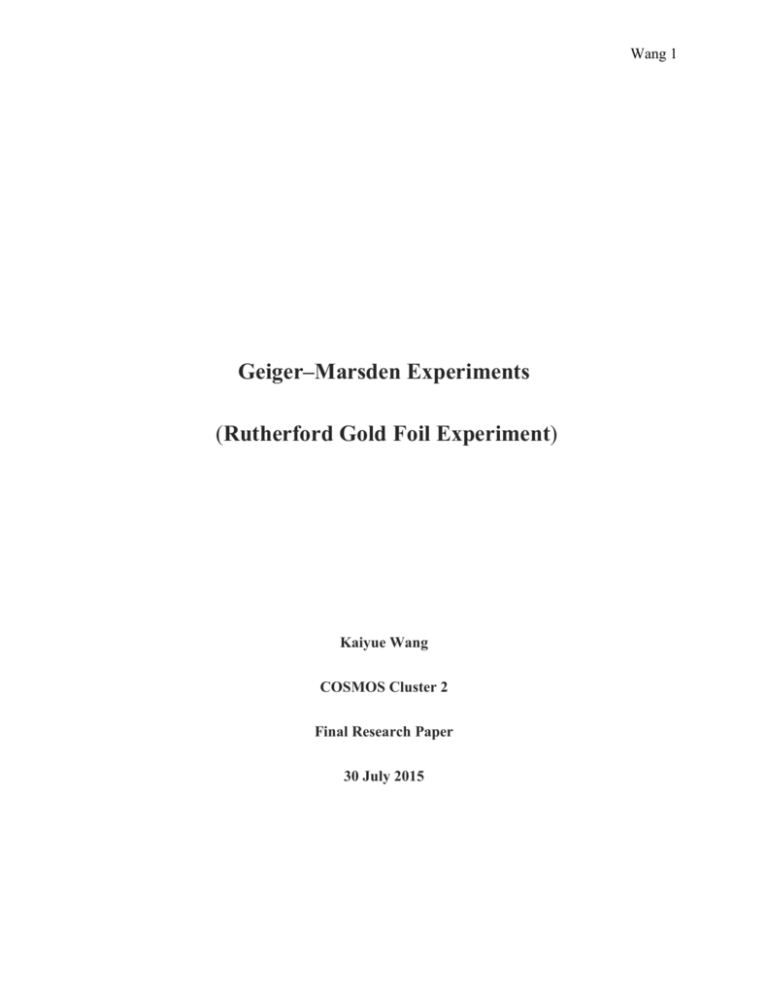
Wang 1 Geiger–Marsden Experiments (Rutherford Gold Foil Experiment) Kaiyue Wang COSMOS Cluster 2 Final Research Paper 30 July 2015 Wang 2 Ernest Rutherford Abstract The main subject of this paper is the discovery of the nucleus of the atom as well as the structure of it using alpha particles by Ernest Rutherford. The methods and preparation of the experiment will be elaborated as well as its effects. The main experiment is the gold foil experiment where the nucleus was discovered with Rutherford’s theory backing it up. Rutherford’s theory would then be verified by a further experiment. He is the man who brought nuclear physics to the surface of the world wide world. Ernest Rutherford, known as “the father of the atom”, “greatest experimentalist physicist since Faraday”, is mostly recognized for his gold foil experiment in finding the nuclei. Although this discovery may seem minimal, it laid the ground work for countless of experiments later in the discovery of subatomic particles and their natures. His work in radiation in nuclear physics along with his gold foil experiment helped him come up with the Rutherford model of the atom. A small structure in the atom that held charged particles. Rutherford’s discovery did not really emulate a genius nature about him, but he was a man of outstanding charisma. He was a genius Wang 3 at finding the best scientists to gather around him and develop healthful relationships along with his constant findings and discoveries. His ability to overcome hardships while producing results serves as an inspiration to many. “He is a very great man whom few can emulate, but everybody can admire” (11, The Great Nobel Prizes) . Ernest lived a very fortunate life as education started to become free as he started to grow up. Many schools he would attend in the future started to take shape as he was just born. His parents, James and Martha Rutherford new that education was essential and made many sacrifices for him to become educated. Rutherford himself was not viewed as a prodigy or genius as he child, he was a lively boy as he attended Foxhill for his primary education. However, what really propelled him into the interest and world of science was a small primer of science by Balfour Stewart he had in 1881. He would love his science classes and apply concepts he learned to different ideas. He learned to calculate the distance away from a canon from hearing the noise and applied it to finding the distance away from a flashing light. The idea of simplicity in the books he read about the fundamentals really became apparent as his most famous experiments had very simplistic models. Rutherford grew and scored very well on his entrance exams and attended Nelson College, scoring 580 out 600 on it. Here the headmaster, Mr W. J. Ford, who came from Cambridge and was a former master at Marlborough in New England, was an extremely influential character in Rutherford’s life as he laid down the foundation of his further inquiries in science. Rutherford really became the epitome of being well-rounded, not only was he on the rugby team, he also received countless awards in mathematics and even subjects such as History, English Literature, French and Latin. This was result from his immense genius ability to concentrate in physical endeavors as well as mental. Rutherford studied at Nelson College for three years until his abnormal skill level in concentration finally was rewarded. Rutherford tried Wang 4 out for a Junior University Scholarship which would enable him to take work in the University of New Zealand. Rutherford went to take the examination as he was urged by his headmaster and was by no means certain of the results. He, in fact, under-estimated himself. Once he heard news that he got it, he was extremely emphatic, making this his first large step that would propel him into the heads of science. There students described him by no means a genius, but a frank likable guy who pursed his goals like a hawk. There he would get a bachelors in arts and his bachelor’s in science. Here he really established his line of work as a physicist. Ernest Rutherford’s journey and dreams of pursing his interests at top facilities come true when J.J. Thomson, a professor at the Cavendish Laboratory at Cambridge, invited him to this top physics lab in the world to work with him. The program he entered was the first of its kind. It was a graduate program for people that did not attend Cambridge University. Ernest and Thomson started with work regarding the magnetic detection of Hertzian waves. They got to the point where they could detect waves from half a mile away. This, however, did not gain enough recognition because the extent of communication using these would only give a chirp of static. This point was the turning point as he really started to get into nuclear physics. The science community was headed into a new direction as the X-Ray was introduced by Professor Routgen. Rutherford’s and Thomson started to investigate why the X-Ray was able to make air an electrical conductor, when it normally acts as an insulator. The two great minds realized the XRay turned air molecules into electrified molecules, some positive and some negative. This became the basis of Thomson’s discovery of the electron when he found that the mysterious cathode rays were in fact corpuscles of negative characterizes. Wang 5 Rutherford, on the other hand was working on his ultraviolet light and discovered the light caused the same ionization of ions behaved the same way as x-rays. He measured the velocity of the ions by an ingenious piece of experimentation as shown: Rutherford used an electrometer instead of an electric plate as the plate created limitations. There is a uniform layer of uranium on plate A. The ultraviolet ray is shot through and ionizes the particles between the plate A and B. The amount of ionization measure is called “saturation current” received at B when the potential difference between A and B is great enough to pull all ions to the plate before they recombine. Rutherford then covered the uranium with aluminum sheets in order to measure the current with his electrometer. Rutherford was checking to see if Becquerel, an earlier experimentalist who tested the uranium with metal plates, was right about uranium radiation having two distinct parts (This was apparent because rays were unequally absorbed). Rutherford did find two “rays”* with this experiment and identified them as alpha and beta particles. The equation he used at the time was: 1. r = exp (-λd) Wang 6 - In this case the “r” represents the intensity of the radiation after passing through a distance of “d” through the substance to the intensity when it is removed. An equation that is better understandable is: 2. I = Io exp (-λt) - Io is the current with nothing covering the uranium plate. - I is the current at each thickness - t is thickness of the aluminum - λ is the coefficient on absorption. Explanation: If uranium rays are homogenous, consisting of one part, then λ will remain constant as t is increased and I goes down. This, however, did not happen. He found that λ did stay constant for only a few values and then suddenly dropped to another value, where it remained as the thickness of aluminum increased. As a result he concluded there are two parts of uranium, and alpha particle and a beta particle. The Three Particles: Rutherford at the time thought the alpha and beta particles he discovered were actually rays and not particles. He did however know that there was a certain charge to these particles. The Alpha particle is the largest out and slowest out of the particles, it has the least penetrating ability as it instead knocks off electrons ionizing the particle while losing all its energy. The beta particle was much smaller and faster, however, it is charged and slows down is decelerated by electromagnetic interactions. The last particle is the gamma ray, the most penetrating as it contains no charge. Rutherford found that this particle to be X-rays, which had the same effect in activating gasses for X-rays. Wang 7 This discovery really catapulted Ernest Rutherford into the global community. Wanting to pursue his marriage with his wife Mary Newton, he moved over to McGill University in Canada. There he would continue his investigation on radioactivity. His discovery of the element Radon was a big factor in his further research in Canada. The element was involved in him winning the Nobel Prize regarding his work on “hos investigation into the disintegration of the elements and the chemistry of radioactive substances”. This however was the Nobel Prize of Chemistry. McGill is the place where he discovered a peculiar property of thorium, a resultant of the decay of radium. Along with thorium emitting alpha and beta “rays” he found that it emitted a third “ray”. This was eventually called the gamma ray. Rutherford also discovered the decay of thorium and this would establish the grounds of definite physical methods in identifying elements because of their unique exponential decay life or half-life. This was explained in Rutherford’s and Soddy’s theory of radioactive disintegration which consisted of these postulates: 1. The atomic nuclei of the radioactive elements are unstable and liable to disintegrate any moment. 2. The disintegration is spontaneous, i.e., constantly breaking. The rate of breaking is not affected by external factors like temperature, pressure, chemical combination etc. 3. During disintegration, atoms of new elements called daughter elements having different physical and chemical properties than the parent elements come into existence. 4. During disintegration, either alpha or beta particles are emitted from the nucleus. The disintegration process may proceed in one of the following two ways, Alpha radiation: Wang 8 An alpha particle is essentially and helium nucleus. Beta radiation: Gamma Radiation: Essentially the emission of a neutron. Gamma rays are emitted especially when large elements decay and are essential to modern nuclear technology. Rutherford continued one this radioactive disintegration and focused on the role of the alpha particle on it. He suggested that the atom was essentially composed of helium nuclei and could not be separated by molecular forces unless through mass heat emission of decay. He proved that the heat emitted were the alpha particles. Rutherford would eventually move from Canada back to England where he would be able to start his most prolific experiments in history, really paving the way for future scientists. Manchester was very enticing and moved there to do research and teach as a professor. Manchester’s facilities were not as good as the ones in McGill, but they were still better than many others. Ernest Rutherford’s presence made the physics department of the school world renowned attracting Otto Hahn from Cavendish and Moseley from Oxford. Here Rutherford still Wang 9 focused on his beloved alpha particle in dealing with a behavior called scattering. This was quite contrary to Thomson’s model as he claimed that alpha particles should not scatter at all and pass right though the metal foil. Rutherford was actually not the man to first conduct the gold foil experiment, he was the man that gave meaning to it. Geiger and Marsden conducted this experiment using the scintillation method to measure the scattering of the alpha particles. Geiger preformed the prototype of the experiment using a narrow flat beam of particles produced by a suitable slit, which was allowed to fall on a screen of phosphorescent zinc sulfide, the whole being enclosed in a vacuum to avoid any scattering by air. A piece of metal was then place in front of the source and there was scattering. This experiment only allowed slight angles of scattering. However it did show that the amount of scattering increased as the thickness of the foil increased and with the atomic weight of the metal. With further experiments regarding this, they created the most famous setup in 1913. This is his 1910 experiment: Bulb B contains the radium emanation and is pumped up through the use of mercury up the tube into the narrow tube A. S contains the a fluorescent zinc sulfide screen. The ray is then narrowed even more by the slit at D. The metal foil is then placed at D and E to observe how the zone of Wang 10 flashes changed. He could also adjust the velocity of the rays by adding more sheets of mica or aluminum at point A. He arrived with these sets of rules: - the most probable angle of deflection increases with the thickness of the material - the most probable angle of deflection is proportional to the atomic mass of the substance - the most probable angle of deflection decreases with the velocity of the alpha particles - the probability that a particle will be deflected by more than 90° is vanishingly small Rutherford was extremely intrigued by this and created his own theory about the structure of the atom. He published a paper called The Scattering of α and β Particles by Matter and the Structure of the Atom. In this paper he theorized that each of the large-angle deflections of the alpha particles must be due to a single encounter and that the only single collision that could produce such a deflection would be one with a very small, heavy charged particle. The atom, he theorized must contain a central particle, very small in comparison to the atom itself. This area would be where close to all of the mass is concentrated. He also said that the atom must have a large charge, many times greater than electronic charge. So, to render the atom neutral, he theorized that the central particle must be surrounded by a sphere of electrification thinly spread of the opposite charge. This was the first conception he offered about the structure of the atom. Rutherford was mainly concerned about the scattering of the alpha particles and just assumed that the nucleus was positive, although he could not prove it because both charges fit his model. Wang 11 Single Reflection Rutherford showed that the path of the alpha particle must be a curve of the kind know as a hyperbola. The more closely the particle is aimed at the atom, the more sharply it comes back. The diagram on the right shows the Thomson path of the particle as the bolded dotted line, while the solid bold line is actual path the alpha particle followed. Rutherford was able to model an equation regarding the probability of a given direction of single scattering with an alpha particle of given velocity striking a foil of material of known atomic mass and velocity. The equation is show below: s = the number of alpha particles falling on unit area at an angle of deflection Φ r = distance from point of incidence of α rays on scattering material (radius) X = total number of particles falling on the scattering material n = number of atoms in a unit volume of the material (moles) t = thickness of the foil (in this case, gold or aluminum foil). Wang 12 Qn = positive charge of the atomic nucleus Qα = positive charge of the alpha particles m = mass of an alpha particle v = velocity of the alpha particle Geiger and Marsden would undertake a detailed experiment to investigate how the scattering angle varied with the different quantities involved in Rutherford’s equation. This experiment is one of the better known of all the experiments performed, the iconic Gold Foil Experiment. They found the results of the experiment agreed very well with his experiments and theory. This was all explained in their paper, The Laws of Deflection of α Particles Through Large Angles. They tested that the number of scintillations observed at a given angle Φ should be proportional to these parts of the equation: 1. csc4Φ/2 2. thickness of foil t 3. magnitude of central charge Qn 4. 1/(mv2)2 The 1913 paper published by the two researchers did four experiments to prove these relationships. Wang 13 To test the variation of scattering of the angle of deflection, csc4Φ/2, They constructed a hollow cylindrical apparatus on a turn table. Inside the cylinder is mounted a metal foil (F) where it is mounted on a rod (T) which is detached from the turn table so the turn table could rotate. Air could be also pumped up from the rod (T). A Microscope (M) is attached to the cylinder to view the deflection. The Microscope is covered by a fluorescent zinc sulfide screen (S) as the objective lens. Geigor could move the turn table in a full circle and could observe and count particles deflected up to 150 degrees. After correcting for experimental error, the number of particles that are deflected at a given angle Φ where proportional to csc4Φ/2. Geiger and Marsden the tested how the scattering varied different thicknesses. There apparatus is show here: Wang 14 The Scientists drilled six holes into a disc (S). The holes were then covered by metal foil (F) of varying thickness or none for a control. The disc was covered by two glass plates (B and C). A disk could be rotated on a rod (P) to bring each metal foil (F) to the alpha ray sources (R). Zinc Sulfide screen is placed behind the disc to record the number of scintillations. They found through this experimentation that the thickness was proportional to Rutherford’s equation. Geiger and Marsden used the same apparatus above to measure how the scattering pattern varied with the square of the nuclear charge. They did not know whether the charge was positive or not, but they assumed it was proportional to atomic weight. So, they whether the scattering was proportional to the weight squared. They placed different metals inside the holes including gold, aluminum, tin, silver, and copper. To measure this, they counted the number of scintillations per minute over the respective foils air equivalent and then divided by the square root of the atomic number. They knew that the number of atoms was proportional to the square root of the atomic weight. The ratios they found were very close to that of the ones calculated by the equation. s ∝ Qn2 Wang 15 Lastly they wanted to test how the velocity of the alpha particle affected the scattering of them. They wanted to see of s ∝ 1/v4 as this isolates the equation for velocity. To slow the alpha particle down, they placed mica in front of the alpha ray to slow the particles down. Again, they found that the number of scintillations was proportional to 1/v4. Rutherford catapulted nuclear physics as one of the leading scientific fields in the world. His discovering of the nucleus and his model of the atom really help the field of chemistry grow. His finding that the nucleus contained a positively charged particle, proton, and his eventual discovery of the neutron gave a legitimist structure of the atom. This model is still widely accepted as a basis and is the first thing chemistry students are taught. It can be thought of as the basis of chemistry. His discovering also lead to the widely popular field today known as quantum mechanics. His discovering really created a ripple that is still existent in today’s society. As the father of nuclear physics, one can assume that any develops there one are somehow linked to his discovery and work. It really bring weight today society as the discovery of the existence of the nucleus is apparent in today’s use of nuclear technology and how it affects the world politically and keeps countries in check. To an extent, his work is keeping peace in the world because of the fear of nuclear warfare. Wang 16 Work Cited Andrade, E. N. Da C. Rutherford and the Nature of the Atom. Garden City, NY: Doubleday, 1964. Print. Birks, J. B. Rutherford at Manchester. New York: W.A. Benjamin, 1963. Print. Boltz, Cecil Leonard. Ernest Rutherford. London: Distributed by Heron, 1970. Print. Rowland, John. Ernest Rutherford. Atom Pioneer. Laurie: London, 1955. Print. Rutherford, Ernest; Ratcliffe, John A. (1938). "Forty Years of Physics". In Needham, Joseph; Pagel, Walter. Tibbetts, Gary (2007). How the Great Scientists Reasoned: The Scientific Method in Action.


